Consider a second order circuit of the series combination of R, C,
and L, connected to an input voltage source  . We can treat
any of the voltages
. We can treat
any of the voltages  ,
,  , and
, and  , across R, C,
and L, respectively as the output. The second order system can be
used as a band-pass (BP), high-pass (HP), or low-pass (LP) filter,
if the voltage across R, L, or C is treated as the output. In general,
the resonant frequency
, across R, C,
and L, respectively as the output. The second order system can be
used as a band-pass (BP), high-pass (HP), or low-pass (LP) filter,
if the voltage across R, L, or C is treated as the output. In general,
the resonant frequency  of a system is the frequency
at which the magnitude of its frequency response function is maximized.
In the following, we specifically consider the magnitude of the
frequency response function (FRF) of these filters. In particular,
we will consider
of a system is the frequency
at which the magnitude of its frequency response function is maximized.
In the following, we specifically consider the magnitude of the
frequency response function (FRF) of these filters. In particular,
we will consider
 when
when  ,
,
 ,
,
 , and
, and
 .
.
- 2nd-order Band-pas Filter:
If the voltage across  is treated as the output, we have
is treated as the output, we have
 |
(320) |
The FRF of the system is
At the natural frequency
 , the imaginary
part of the denominator
, the imaginary
part of the denominator
 is zero and
is zero and
 is the maximum, i.e., the resonant frequency is the
same as the natural frequency
is the maximum, i.e., the resonant frequency is the
same as the natural frequency
 . When
. When
 , we have
, we have
 .
In particular:
.
In particular:
This is a band-pass filter with the bandwidth defined as:
 |
(322) |
where
 and
and
 are the two
cut-off frequencies at which
are the two
cut-off frequencies at which
 or or |
(323) |
In other words, the power of the output is halved when compared to
that of the input. The cut-off frequency is therefore also called the
half-power frequency. To find the bandwidth of this 2nd order
system, we rewrite the FRF as:
 |
(324) |
Note that
 when the imaginary part of the
denominator is:
when the imaginary part of the
denominator is:
 |
(325) |
To solve this equation for the cut-off frequency, we multiply both sides
by
 , and get two quadratic equations:
, and get two quadratic equations:
 |
(326) |
with four roots:
 |
(327) |
Ignoring the negative roots (with no physical meaning) we get
the two cut-off frequencies  and
and  :
:
 |
(328) |
and the bandwidth is
 |
(329) |
This happens to be the coefficient of the first order term in the
canonical form of the second order system, which can now be written as:
 |
(330) |
The equation
 is of great importance as
it directly relates the bandwidth
is of great importance as
it directly relates the bandwidth
 and the natural
frequency
and the natural
frequency  .
.
The middle point between the two cut-off frequencies  and
and
 is
is
 |
(331) |
which is greater than the resonant frequency
 ,
and we have
,
and we have
 .
.
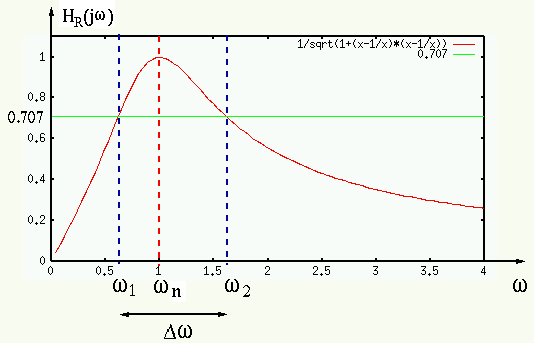
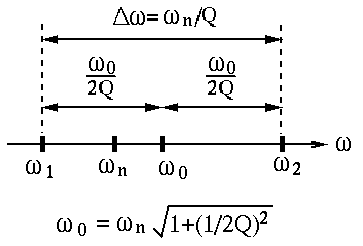
If
 (typically
(typically  , i.e.,
, i.e.,
 ),
we have
),
we have
 ,
,
 , and
, and
 |
(332) |
 |
(333) |
- 2nd-order High-pass Filter:
If the voltage across  is treated as the output, we have
is treated as the output, we have
This is a high-pass filter as
To decide whether
 peaks and, if so, to find the resonant
frequency, we consider
peaks and, if so, to find the resonant
frequency, we consider
and set its derivative with respect to  to zero:
to zero:
For this equation to hold, the numerator needs to be zero:
![$\displaystyle 4\omega^3[(\omega_n^2-\omega^2)^2+4\zeta^2\omega^2\omega_n^2]
=4\omega^5[\omega^2-\omega^2_n+2\zeta^2\omega_n^2]$](img930.svg) |
(337) |
Solving this for  , we get the resonant frequency:
, we get the resonant frequency:
 |
(338) |
Now consider the following three cases:
- If
 , i.e.,
, i.e.,
 , then
, then
 is real and
is real and
 peaks at
peaks at  :
:
 |
(339) |
If  is small,
is small,
 . For example,
. For example,
 ,
,
 .
.
- If
 , then
, then
 , and
, and
 |
(340) |
or
 , i.e.,
, i.e.,  is the
cut-off frequency of the HP filter.
is the
cut-off frequency of the HP filter.
- If
 ,
,  is imaginary, indicating
there does not exist a frequency at which
is imaginary, indicating
there does not exist a frequency at which
 peaks.
peaks.
- 2nd-order Low-pass Filter:
If the voltage across  is treated as the output, we have
is treated as the output, we have
This is a low-pass filter as
To decide whether
 peaks and, if so, to find the resonant
frequency, we consider
peaks and, if so, to find the resonant
frequency, we consider
 |
(342) |
To find  that maximizes
that maximizes
 or equivalently
minimizes its denominator (with constant numerator), we set the
derivative of the denominator with respect to
or equivalently
minimizes its denominator (with constant numerator), we set the
derivative of the denominator with respect to  to zero:
to zero:
Solving for  we get the resonant frequency:
we get the resonant frequency:
 |
(344) |
Now consider the following three cases:
- If
 , i.e.,
, i.e.,
 , then
, then
 is real and
is real and
 peaks at
peaks at  :
:
 |
(345) |
If  is small,
is small,
 . For example,
. For example,
 ,
,
 .
.
- If
 , we have
, we have
 , and
, and
 |
(346) |
or
 , i.e.,
, i.e.,  is the
cut-off frequency of the LP filter.
is the
cut-off frequency of the LP filter.
- If
 ,
,  is imaginary, indicating
there does not exist a frequency at which
is imaginary, indicating
there does not exist a frequency at which
 peaks.
peaks.

At the natural frequency, the impedance of a series RCL circuit reaches
minimum, consequently the current reaches maximum and so does the voltage
across the resistor. However, the voltage across the inductor reaches
maximum at a frequency slightly higher than the natural frequency, and
the voltage across the capacitor reaches maximum at a frequency slightly
lower than the resonant frequency, as shown in the linear and log-scale
plots below. (For Bode plots, see
here.)
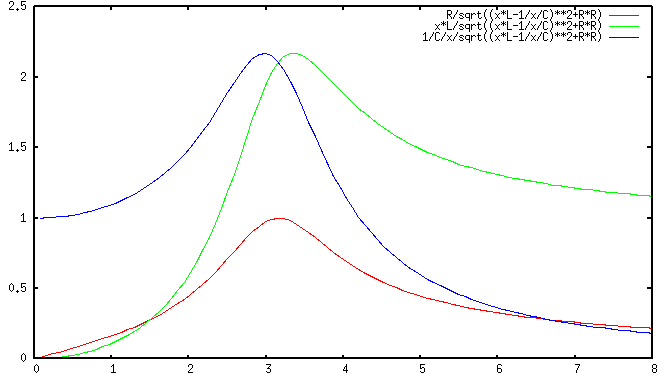
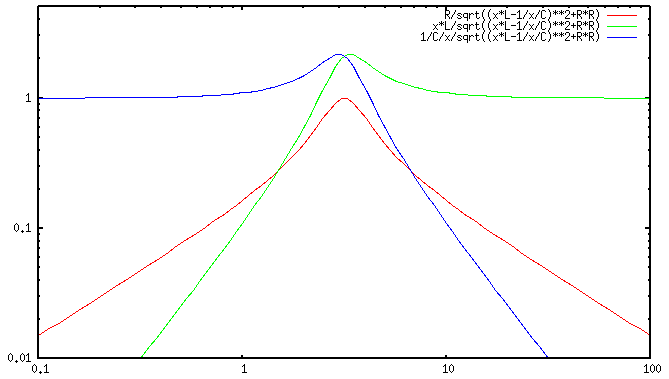
In summary,
- Low-pass filter:
 |
(347) |
- High-pass filter:
 |
(348) |
- Band-pass filter:
 |
(349) |
- Band-stop filter:
 |
(350) |
- All-pass filter:
 |
(351) |
For a parallel RCL circuit with current input, due to the duality between
current and voltage, parallel and series configuration, the same derivation
of bandwidth can be carried out to obtain the same conclusions.
While the phenomenon of resonance can be destructive in mechanical systems
(for example, the famous story of the
Angers bridge),
and it therefore needs to be avoided, it can also be very useful in electrical
system such as in the tuning circuit in radio or TV broadcasting.
Example: Given the RLC circuits below, find what kind of filters they
are (HP, LP, BP, or BS).

The impedance of the parallel combination of  and
and  is:
is:
 |
(352) |
At the resonant frequency
 ,
,
 (open-circuit):
(open-circuit):
 |
(353) |
- The FRF of the first circuit is
 |
(354) |
When
 ,
,
 ,
,  . In this case
no current goes through
. In this case
no current goes through  and the voltage drop across it is zero,
then the output voltage is the same as the input voltage. Otherwise
either
and the voltage drop across it is zero,
then the output voltage is the same as the input voltage. Otherwise
either
 or
or
 ,
,  is finite, the
voltage across
is finite, the
voltage across  is non-zero, the output voltage is reduced. This is
a band-pass filter:
is non-zero, the output voltage is reduced. This is
a band-pass filter:
 |
(355) |
- The FRF of the second circuit is
 |
(356) |
when
 ,
,
 ,
,  . In this case,
the LC parallel branch is an open-circuit, the output voltage is
zero. Otherwise either
. In this case,
the LC parallel branch is an open-circuit, the output voltage is
zero. Otherwise either
 or
or
 ,
,
 is finite, the voltage is non-zero. The circuit is a
band-stop or band-block filter:
is finite, the voltage is non-zero. The circuit is a
band-stop or band-block filter:
 |
(357) |
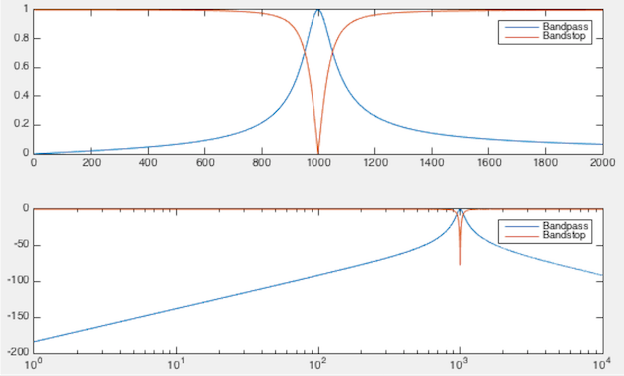
Example: Find the bandwidth of each of the two filters above as
a function of  ,
,  and
and  . Determine whether the peak frequency
. Determine whether the peak frequency
 is lower or higher than the center of the passing/stop
band. Design a band-pass and a band-stop filter so that the peak
frequency is
is lower or higher than the center of the passing/stop
band. Design a band-pass and a band-stop filter so that the peak
frequency is
 and the bandwidth is
and the bandwidth is
 .
.
The bandwidth is defined as
 , the
difference between the two cut-off frequencies
, the
difference between the two cut-off frequencies
 and
and
 at which
at which
 . For both filters,
the cut-off frequencies can be found by solving
. For both filters,
the cut-off frequencies can be found by solving
 |
(358) |
i.e., the two filters always have the same bandwidth.
 |
(359) |
Solving these two quadratic equations and take the positive roots
of each, we get
 |
(360) |
The bandwidth is
 |
(361) |
The center of the bandwidth is greater than peak frequency:
 |
(362) |
Given the desired properties:
 |
(363) |
we further get
 |
(364) |
If we let  , then we get
, then we get
 ,
,
 ,
and
,
and
 |
(365) |



























 and
and
 are the two
cut-off frequencies at which
are the two
cut-off frequencies at which
 or
or

 when the imaginary part of the
denominator is:
when the imaginary part of the
denominator is:

 , and get two quadratic equations:
, and get two quadratic equations:


 and
and  :
:



 is of great importance as
it directly relates the bandwidth
is of great importance as
it directly relates the bandwidth
 and the natural
frequency
and the natural
frequency  .
.



 ,
and we have
,
and we have
 .
.


















 peaks and, if so, to find the resonant
frequency, we consider
peaks and, if so, to find the resonant
frequency, we consider



 to zero:
to zero:


![$\displaystyle \frac{d}{d\omega}\left[\frac{\omega^4}{(\omega_n^2-\omega^2)^2
+(2\zeta\omega\omega_n)^2}\right]$](img928.svg)

![$\displaystyle \frac{4\omega^3[(\omega_n^2-\omega^2)^2+4\zeta^2\omega^2\omega_n^...
...^2\omega\omega_n^2]}{[(\omega_n^2-\omega^2)^2+4\zeta^2\omega^2\omega_n^2]^2} =0$](img929.svg)
![$\displaystyle 4\omega^3[(\omega_n^2-\omega^2)^2+4\zeta^2\omega^2\omega_n^2]
=4\omega^5[\omega^2-\omega^2_n+2\zeta^2\omega_n^2]$](img930.svg)
 , we get the resonant frequency:
, we get the resonant frequency:

 , i.e.,
, i.e.,
 , then
, then
 is real and
is real and
 peaks at
peaks at  :
:

 is small,
is small,
 . For example,
. For example,
 ,
,
 .
.
 , then
, then
 , and
, and

 , i.e.,
, i.e.,  is the
cut-off frequency of the HP filter.
is the
cut-off frequency of the HP filter.
 ,
,  is imaginary, indicating
there does not exist a frequency at which
is imaginary, indicating
there does not exist a frequency at which
 peaks.
peaks.









 peaks and, if so, to find the resonant
frequency, we consider
peaks and, if so, to find the resonant
frequency, we consider

 that maximizes
that maximizes
 or equivalently
minimizes its denominator (with constant numerator), we set the
derivative of the denominator with respect to
or equivalently
minimizes its denominator (with constant numerator), we set the
derivative of the denominator with respect to  to zero:
to zero:


![$\displaystyle \frac{d}{d\omega} [(\omega_n^2-\omega^2)^2+4\zeta^2\omega_n^2\omega^2]$](img953.svg)


 we get the resonant frequency:
we get the resonant frequency:

 , i.e.,
, i.e.,
 , then
, then
 is real and
is real and
 peaks at
peaks at  :
:

 is small,
is small,
 . For example,
. For example,
 ,
,
 .
.
 , we have
, we have
 , and
, and

 , i.e.,
, i.e.,  is the
cut-off frequency of the LP filter.
is the
cut-off frequency of the LP filter.
 ,
,  is imaginary, indicating
there does not exist a frequency at which
is imaginary, indicating
there does not exist a frequency at which
 peaks.
peaks.












 ,
,
 (open-circuit):
(open-circuit):


 ,
,
 ,
,  . In this case
no current goes through
. In this case
no current goes through  and the voltage drop across it is zero,
then the output voltage is the same as the input voltage. Otherwise
either
and the voltage drop across it is zero,
then the output voltage is the same as the input voltage. Otherwise
either
 or
or
 ,
,  is finite, the
voltage across
is finite, the
voltage across  is non-zero, the output voltage is reduced. This is
a band-pass filter:
is non-zero, the output voltage is reduced. This is
a band-pass filter:


 ,
,
 ,
,  . In this case,
the LC parallel branch is an open-circuit, the output voltage is
zero. Otherwise either
. In this case,
the LC parallel branch is an open-circuit, the output voltage is
zero. Otherwise either
 or
or
 ,
,
 is finite, the voltage is non-zero. The circuit is a
band-stop or band-block filter:
is finite, the voltage is non-zero. The circuit is a
band-stop or band-block filter:



















 , then we get
, then we get
 ,
,
 ,
and
,
and
